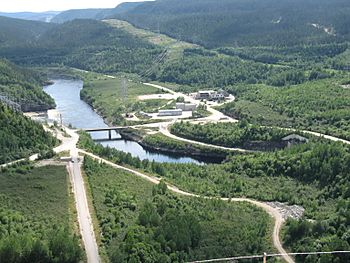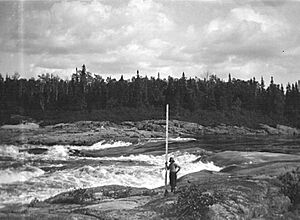Manicouagan River facts for kids
Quick facts for kids Manicouagan River |
|
|---|---|

Manicouagan River as seen from the Daniel-Johnson Dam
|
|

Drainage basin in yellow
|
|
| Country | Canada |
| Province | Quebec |
| Region | Côte-Nord |
| Physical characteristics | |
| Main source | Manicouagan Reservoir Rivière-aux-Outardes 50°38′53″N 68°43′40″W / 50.64806°N 68.72778°W |
| River mouth | Gulf of Saint Lawrence Pointe-Lebel 0 m (0 ft) 49°10′34″N 68°11′40″W / 49.17611°N 68.19444°W |
| Length | 200 km (120 mi) |
| Basin features | |
| Basin size | 45,800 km2 (17,700 sq mi) |
| Tributaries |
|
The Manicouagan River is a big river in the Côte-Nord region of Quebec, Canada. People often call it just Manic. This river starts in the Manicouagan Reservoir and flows about 200 kilometers (124 miles) south. It then empties into the Saint Lawrence River near Baie-Comeau.
The Manicouagan Reservoir, also known as Lake Manicouagan, is very special. It sits inside what's left of an ancient impact crater. This crater was formed when a huge asteroid, about 5 kilometers (3 miles) wide, crashed into Earth a long, long time ago. The original crater was about 100 kilometers (62 miles) wide. Over time, erosion and sediments have made the visible part smaller, about 72 kilometers (45 miles) wide. The Manicouagan crater is the sixth-largest confirmed impact crater on Earth!
Contents
What's in a Name?
The name of the Manicouagan River has an interesting history. Many believe it comes from the Innu-aimun language, meaning "Place where Tree Bark is Found." This suggests that people used to collect tree bark there.
However, the Innu people from Pessamit have a different name for it. They call it Menukuanistuk Shipu, which means "River of the Cup." This might refer to the shape of the Manicouagan Reservoir, which looks like a giant cup or ring from above.
Rivers Joining In
A tributary is a smaller river or stream that flows into a larger river or lake. The Manicouagan River has several important tributaries that feed into it.
The main rivers that join the Manicouagan River, starting from further upstream, include:
- Toulnustouc River
- Lemay River
- And, of course, the Manicouagan Reservoir itself, which collects water from rivers like the Mouchalagane River and the Seignelay River.
A Look Back in Time
In August 1535, a famous explorer named Jacques Cartier was sailing south. He noticed the mouth of this big river but didn't give it a name.
Later, in June 1664, a Jesuit missionary named Henri Nouvel was the first to travel upstream. He called it the "Grand Manikouaganistikou River." The French people at the time called it rivière Noire, which means "Black River," because of how deep its waters were. The spelling of the river's name has stayed pretty much the same since then.
In the early 1950s, the Manicouagan River became very important. The company Hydro-Québec saw its potential for making hydroelectricity. Hydroelectricity is power made from moving water. Because the river had deep and fast-flowing waters, it was perfect for building dams.
In 1956, the first dam was built on Lake Sainte-Anne. This helped control the flow of the Toulnustouc River, which is a major tributary of the Manicouagan. Four years later, in 1960, the main construction began. Huge dams and power stations were built on the Manicouagan River and a nearby river called the Outardes River. By 1978, this massive project was finished. It could produce a lot of electricity, enough to power many homes and businesses.
Power from Water: Hydro-electric Dams
The Manicouagan River is home to several large hydroelectric power plants. These plants are part of a big project called the Manic-Outardes Project. They use the force of the river's water to spin turbines and create electricity.
Here are some of the main power stations on the Manicouagan River:
- McCormick generating station: This plant can produce 335 megawatts (MW) of power. It is owned by Hydro-Québec and Alcoa.
- Manic 1 generating station: This plant produces 184 MW of power and is operated by Hydro-Québec.
- Jean-Lesage generating station: This used to be called Manic-2 Power Station. It's a big one, producing 1024 MW, and is operated by Hydro-Québec.
- René-Lévesque generating station: Formerly known as Manic-3 Power Station, it produces 1244 MW and is also operated by Hydro-Québec.
- Daniel-Johnson Dam: This is a very famous dam. It has two power stations:
- Manic-5 generating station: This station produces 1592 MW.
- Manic-5-PA generating station: This station produces 1064 MW.
Both Manic-5 and Manic-5-PA are operated by Hydro-Québec.
These dams and power stations are a huge part of Quebec's electricity supply, showing how important the Manicouagan River is.
Images for kids
See also
 In Spanish: Río Manicouagan para niños
In Spanish: Río Manicouagan para niños



